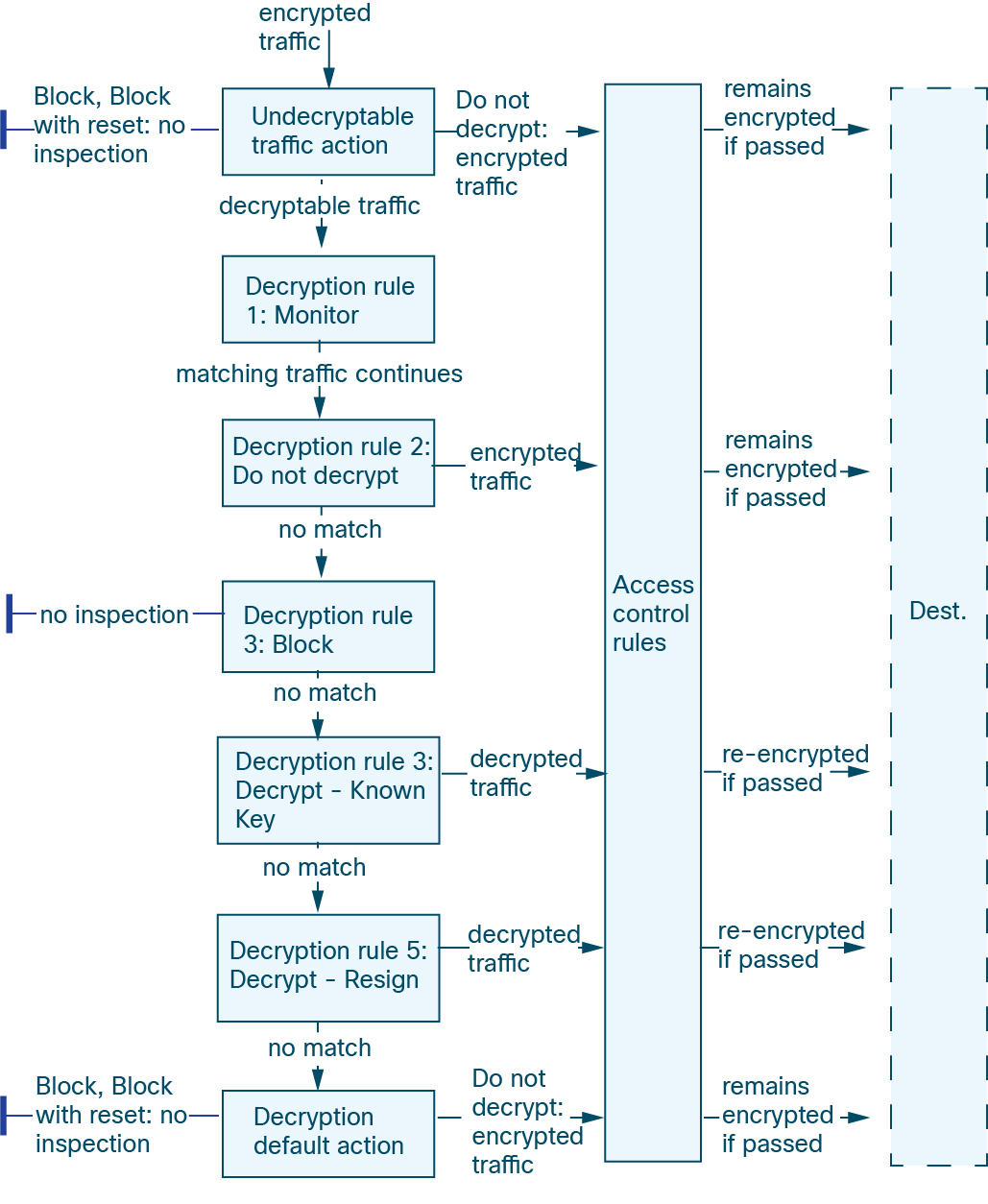Decryption rule traffic handling
The system matches traffic to decryption rules in the order you specify. In most cases, the system handles encrypted traffic according to the first decryption rule where all the rule’s conditions match the traffic. Conditions can be simple or complex; you can control traffic by security zone, network or geographical location, VLAN, port, application, requested URL, user, certificate, certificate distinguished name, certificate status, cipher suite, or encryption protocol version.
Each rule also has an action, which determines whether you monitor, block, or inspect matching encrypted or decrypted traffic with access control. Note that the system does not further inspect encrypted traffic it blocks. It does inspect encrypted and undecryptable traffic with access control. However, some access control rule conditions require unencrypted traffic, so encrypted traffic may match fewer rules. Also, by default, the system disables intrusion and file inspection of encrypted payloads.
The following scenario summarizes the ways that decryption rules handle traffic in an inline deployment.

In this scenario, traffic is evaluated as follows:
-
Undecryptable Traffic Action evaluates encrypted traffic first. For traffic the system cannot decrypt, the system either blocks it without further inspection or passes it for access control inspection. Encrypted traffic that does not match continues to the next rule.
-
Decryption Rule 1: Monitor evaluates encrypted traffic next. Monitor rules track and log encrypted traffic but do not affect traffic flow. The system continues to match traffic against additional rules to determine whether to permit or deny it.
-
Decryption Rule 2: Do Not Decrypt evaluates encrypted traffic third. Matching traffic is not decrypted; the system inspects this traffic with access control, but not file or intrusion inspection. Traffic that does not match continues to the next rule.
-
Decryption Rule 3: Block evaluates encrypted traffic fourth. Matching traffic is blocked without further inspection. Traffic that does not match continues to the next rule.
-
Decryption Rule 4: Decrypt - Known Key evaluates encrypted traffic fifth. Matching traffic incoming to your network is decrypted using a private key you upload. The decrypted traffic is then evaluated against access control rules. Access control rules handle decrypted and unencrypted traffic identically. The system can block traffic as a result of this additional inspection. All remaining traffic is reencrypted before being allowed to the destination. Traffic that does not match the decryption rule continues to the next rule.
-
Decryption Rule 5: Decrypt - Resign is the final rule. If traffic matches this rule, the system re-signs the server certificate with an uploaded CA certificate, then acts as a man-in-the-middle to decrypt traffic. The decrypted traffic is then evaluated against access control rules. Access control rules treat decrypted and unencrypted traffic identically. The system can block traffic as a result of this additional inspection. All remaining traffic is reencrypted before being allowed to the destination. Traffic that does not match the decryption rule rule continues to the next rule.
-
Decryption policy Default Action handles all traffic that does not match any of the decryption rules. The default action either blocks encrypted traffic without further inspection or does not decrypt it, passing it for access control inspection.